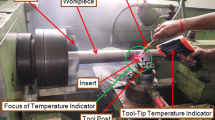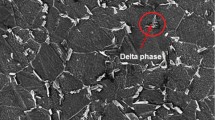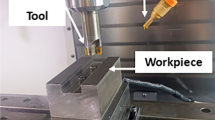Abstract
In the present work, turning performance of Inconel 825 superalloy is studied under Nanofluid Minimum Quantity Lubrication (NFMQL). Nanofluid used is nano-Al2O3 dispersed distilled water. The tool insert used in this study is PVD multi-layered (TiN/ TiCN/ TiN) coated cermet. The following machining performance indicators: tangential cutting force, tool-tip temperature, wear morphologies of the tool insert, macro/ micro-morphologies of chips produced, etc. are studied. It is observed that dry machining environment causes vibration signals of random nature whose frequency and amplitude of acceleration are highly time-variant. On the contrary, periodic vibration signal with lower amplitude of acceleration is detected in case of NFMQL machining. Consequently, NFMQL exhibits lower cutting force, reduced tool-tip temperature, and less severe tool wear than that of dry machining. NFMQL produces thinner chips with shorter segmentation spacing and wider shear angle than dry machining.













Similar content being viewed by others
References
Ezugwu E O and Okeke C I 2000 Performance of PVD coated carbide inserts when machining a nimonic (C-263) alloy at high speed conditions. Tribol. Trans. 43(2): 332–336
Kuo C P, Su S C and Chen S H 2010 Tool life and surface integrity when milling Inconel 718 with coated cemented carbide tools. J. Chin. Inst. Eng. 33(6): 915–922
Nalbant M, Altın A and Gökkaya H 2007 The effect of coating material and geometry of cutting tool and cutting speed on machinability properties of Inconel 718 super alloys. Mater. Des. 28(5): 1719–1724
Kadirgama K, Abou-El-Hossein K A, Noor M M, Sharma K V and Mohammad B 2011 Tool life and wear mechanism when machining Hastelloy C-22HS. Wear 270(3–4): 258–268
Liew P J, Shaaroni A, Sidik N A C and Yan J 2017 An overview of current status of cutting fluids and cooling techniques of turning hard steel. Int. J. Heat Mass Transf. 114: 380–394
Bennett E O 1983 Water based cutting fluids and human health. Tribol. Int. 16(3): 133–136
Debnath S, Reddy M M and Yi Q S 2014 Environmental friendly cutting fluids and cooling techniques in machining: a review. J. Clean. Prod. 83: 33–47
Li K M and Liang S Y 2007 Performance profiling of minimum quantity lubrication in machining. Int. J. Adv. Manuf. Technol. 35(3): 226–233
Yazid M Z A, CheHaron C H, Ghani J A, Ibrahim G A and Said A Y M 2011 Surface integrity of Inconel 718 when finish turning with PVD coated carbide tool under MQL. Procedia Eng. 19: 396–401
Yıldırım Ç V, Kıvak T, Sarıkaya M and Erzincanlı F 2017 Determination of MQL parameters contributing to sustainable machining in the milling of nickel-base superalloy Waspaloy. Arab. J. Sci. Eng. 42(11): 4667–4681
Wang C, Li K, Chen M and Liu Z 2015 Evaluation of minimum quantity lubrication effects by cutting force signals in face milling of Inconel 182 overlays. J. Clean. Prod. 108: 145–157
Kamata Y and Obikawa T 2007 High speed MQL finish-turning of Inconel 718 with different coated tools. J. Mater. Process. Technol. 192: 281–286
Tawakoli T, Hadad M J, Sadeghi M H, Daneshi A, Stöckert S and Rasifard A 2009 An experimental investigation of the effects of workpiece and grinding parameters on minimum quantity lubrication—MQL grinding. Int. J. Mach. Tools Manuf. 49(12–13): 924–932
Vasu V and Reddy G P K 2011 Effect of minimum quantity lubrication with Al2O3 nanoparticles on surface roughness, tool wear and temperature dissipation in machining Inconel 600 alloy. Proc. IMechE, Part N: Journal of Nanomater. Nanoeng. Nanosyst. 225(1): 3–16
Khandekar S, Sankar M R, Agnihotri V and Ramkumar J 2012 Nano-cutting fluid for enhancement of metal cutting performance. Mater. Manuf. Process. 27(9): 963–967
Amrita M, Srikant R R and Sitaramaraju A V 2014 Performance evaluation of nanographite-based cutting fluid in machining process. Mater. Manuf. Process. 29(5): 600–605
Padmini R, Krishna P V and Rao G K M 2015 Performance assessment of micro and nano solid lubricant suspensions in vegetable oils during machining. Proc. IMechE, Part B: J. Eng. Manuf. 229(12): 2196–2204
Paturi U M R, Maddu Y R, Maruri R R and Narala S K R 2016 Measurement and analysis of surface roughness in WS2 solid lubricant assisted minimum quantity lubrication (MQL) turning of Inconel 718. Procedia CIRP. 40: 138–143
Ali M A M, Khalil A N M and Azmi A I 2016 Effect of Al2O3 nanolubrication with Sodium Dodecylbenzene Sulfonate (SDBS) on surface roughness and tool wear under MQL during turning of Ti-6AL-4T. IOP Conf. Ser.: Mater. Sci. Eng. 114(1): 012110 DOI: https://doi.org/10.1088/1757-899X/114/1/012110
Behera B C, Chetan, Setti D, Ghosh S and Rao P V 2017 Spreadability studies of metal working fluids on tool surface and its impact on minimum amount cooling and lubrication turning. J. Mater. Process. Technol. 244: 1–16
Singh R K, Sharma A K, Dixit A R, Tiwari A K, Pramanik A and Mandal A 2017 Performance evaluation of alumina-graphene hybrid nano-cutting fluid in hard turning. J. Clean. Prod. 162: 830–845
Sinha M K, Madarkar R, Ghosh S and Rao P V 2017 Application of eco-friendly nanofluids during grinding of Inconel 718 through small quantity lubrication. J. Clean. Prod. 141: 1359–1375
Virdi R L, Chatha S S and Singh H 2019 Experiment evaluation of grinding properties under Al2O3 nanofluids in minimum quantity lubrication. Mater. Res. Express. 6(9): 096574. https://doi.org/10.1088/2053-1591/ab301f
Sen B, Mia M, Gupta M K, Rahman M A, Mandal U K and Mondal S P 2019 Influence of Al2O3 and palm oil–mixed nanofluid on machining performances of Inconel-690: IF-THEN rules–based FIS model in eco-benign milling. Int. J. Adv. Manuf. Technol. 103(9): 3389–3403
Duc T M, Long T T and Thanh D V 2020 Evaluation of minimum quantity lubrication and minimum quantity cooling lubrication performance in hard drilling of Hardox 500 steel using Al2O3 nanofluid. Adv. Mech. Eng. 12(2): 1687814019888404. https://doi.org/10.1177/1687814019888404
Wang Y, Li C, Zhang Y, Yang M, Zhang X, Zhang N and Dai J 2017 Experimental evaluation on tribological performance of the wheel/workpiece interface in minimum quantity lubrication grinding with different concentrations of Al2O3 nanofluids. J. Clean. Prod. 142: 3571–3583
Liljerehn A 2016 Machine tool dynamics, a constrained state-space substructuring approach, PhD Thesis, Department of Applied Mechanics, Chalmers University of Technology, Göteborg, Sweden (2016)
Byrne G, Dornfeld D, Inasaki I, Ketteler G, König W and Teti R 1995 Tool condition monitoring (TCM) – the status of research and industrial application. Ann. CIRP. 44(2): 541–567
Dimla Snr D E 2000 Sensor signals for tool wear monitoring in metal cutting operations – a review of methods. Int. J. Mach. Tools Manuf. 40(8): 1073–1098
Dimla Snr D E 2002 The correlation of vibration signal features to cutting tool wear in a metal turning operation. Int. J. Adv. Manuf. Technol. 19: 705–713
David A S and John S A 2006 Metal cutting theory and practice. Taylor and Francis 1st edition, 45–69
Carou D, Rubio E M, Lauro C H and Davim J P 2016 The effect of minimum quantity lubrication in the intermittent turning of magnesium based on vibration signals. Measurement. 94: 338–343
Lengauer W and Scagnetto F 2018 Ti (C, N)-based cermets: critical review of achievements and recent developments. Solid State Phenom. 274: 53–100
Sulaiman S, Roshan A and Borazjani S 2013 Effect of cutting parameters on cutting temperature of TiAl6V4 alloy. Appl. Mech. Mater. 392: 68–72
Noordin M Y, Venkatesh V C and Sharif S 2007 Dry turning of tempered martensitic stainless tool steel using coated cermet and coated carbide tools. J. Mater. Process. Technol. 185(1–3): 83–90
Reis B C M, dos Santos A J, dos Santos N F P, Câmara M A, de Faria P E and Abrão A M 2019 Cutting performance and wear behavior of coated cermet and coated carbide tools when turning AISI 4340 steel. Int. J. Adv. Manuf. Technol. 105(1): 1655–1663
Babu M N, Anandan V and Babu M D 2021 Performance of ionic liquid as a lubricant in turning inconel 825 via minimum quantity lubrication method. J. Manuf. Process. 64: 793–804
Marques A, Suarez M P, Sales W F and Machado Á R 2019 Turning of Inconel 718 with whisker-reinforced ceramic tools applying vegetable-based cutting fluid mixed with solid lubricants by MQL. J. Mater. Process. Technol. 266: 530–543
Li H Z, Zeng H and Chen X Q 2006 An experimental study of tool wear and cutting force variation in the end milling of Inconel 718 with coated carbide inserts. J. Mater. Process. Technol. 180(1–3): 296–304
Luo T, Wei X, Huang X, Huang L and Yang F 2014 Tribological properties of Al2O3 nanoparticles as lubricating oil additives. Ceram. Int. 40(5): 7143–7149
Pusavec F, Deshpande A, Yang S, M’Saoubi R, Kopac J, Dillon O W Jr and Jawahir I S 2014 Sustainable machining of high temperature Nickel alloy–Inconel 718: Part 1–predictive performance models. J. Clean. Prod. 81: 255–269
Ahmed Y S, Fox-Rabinovich G, Paiva J M, Wagg T and Veldhuis S C 2017 Effect of built-up edge formation during stable state of wear in AISI 304 stainless steel on machining performance and surface integrity of the machined part. Mater. 10(11): 1230. https://doi.org/10.3390/ma10111230
Hao Z, Gao D, Fan Y and Han R 2011 New observations on tool wear mechanism in dry machining Inconel 718. Int. J. Mach. Tools Manuf. 51(12): 973–979
Khanna N, Shah P and Chetan, 2020 Comparative analysis of dry, flood, MQL and cryogenic CO2 techniques during the machining of 15–5-PH SS alloy. Tribol. Int. 146: 106196. https://doi.org/10.1016/j.triboint.2020.106196
Ghani J A, Haron C H C, Kasim M S, Sulaiman M A and Tomadi S H 2016 Wear mechanism of coated and uncoated carbide cutting tool in machining process. J. Mater. Res. 31(13): 1873–1879
Günan F, Kıvak T, Yıldırım Ç V and Sarıkaya M 2020 Performance evaluation of MQL with Al2O3 mixed nanofluids prepared at different concentrations in milling of Hastelloy C276 alloy. J. Mater. Res. Technol. 9(5): 10386–10400
Chetan Ghosh S and Rao P V 2019 Comparison between sustainable cryogenic techniques and nano-MQL cooling mode in turning of nickel-based alloy. J. Clean. Prod. 231: 1036–1049
Zhang S, Li J, Zhu X and Lv H 2013 Saw-tooth chip formation and its effect on cutting force fluctuation in turning of Inconel 718. Int. J. Precis. Eng. Manuf. 14(6): 957–963
Das S R, Dhupal D and Kumar A 2015 Experimental investigation into machinability of hardened AISI 4140 steel using TiN coated ceramic tool. Measurement. 62: 108–126
Hegab H, Umer U, Soliman M and Kishawy H A 2018 Effects of nano-cutting fluids on tool performance and chip morphology during machining Inconel 718. Int. J. Adv. Manuf. Technol. 96(9): 3449–3458
Thakur D G, Ramamoorthy B and Vijayaraghavan L 2009 Machinability investigation of Inconel 718 in high-speed turning. Int. J. Adv. Manuf. Technol. 45(5–6): 421–429
Dong G, Zhaopeng H, Rongdi H, Yanli C and Muguthu J N 2011 Study of cutting deformation in machining nickel-based alloy Inconel 718. Int. J. Mach. Tools Manuf. 51(6): 520–527
Ning F, Wang F, Jia Z and Ma J 2014 Chip morphology and surface roughness in high-speed milling of nickel-based superalloy Inconel 718. Int. J. Mach. Mach. Mater. 15(3–4): 285–299
Kaynak Y 2014 Evaluation of machining performance in cryogenic machining of Inconel 718 and comparison with dry and MQL machining. Int. J. Adv. Manuf. Technol. 72(5): 919–933
Subramanian S V, Gekonde H O, Zhu G and Zhang X 2002 Role of microstructural softening events in metal cutting. Mach. Sci. Technol.: Int. J. 6(3): 353–364
Oxley P L B 1998 Development and application of a predictive machining theory. Mach. Sci. Technol.: Int. J. 2(2): 165–189
Sayuti M, Sarhan A A, Tanaka T, Hamdi M and Saito Y 2013 Cutting force reduction and surface quality improvement in machining of aerospace duralumin Al-2017-T4 using carbon onion nanolubrication system. Int. J. Adv. Manuf. Technol. 65(9–12): 1493–1500
Peng D X, Kang Y, Hwang R M, Shyr S S and Chang Y P 2009 Tribological properties of diamond and SiO2 nanoparticles added in paraffin. Tribol. Int. 42(6): 911–917
Dash L, Padhan S and Das S R 2020 Experimental investigations on surface integrity and chip morphology in hard tuning of AISI D3 steel under sustainable nanofluid-based minimum quantity lubrication. J. Braz. Soc. Mech. Sci. Eng. 42(10): 1–25
Mia M, Dey P R, Hossain M S, Arafat M T, Asaduzzaman M, Ullah M S and Zobaer S M T 2018 Taguchi S/N based optimization of machining parameters for surface roughness, tool wear and material removal rate in hard turning under MQL cutting condition. Measurement 122: 380–391
Wang Q, Liu Z, Wang B, Song Q and Wan Y 2016 Evolutions of grain size and micro-hardness during chip formation and machined surface generation for Ti-6Al-4V in high-speed machining. Int. J. Adv. Manuf. Technol. 82(9–12): 1725–1736
Joshi S, Tewari A and Joshi S S 2015 Microstructural characterization of chip segmentation under different machining environments in orthogonal machining of Ti6Al4V. J. Eng. Mater. Technol. 137(1): 011005 (16 pages) DOI: https://doi.org/10.1115/1.4028841
Author information
Authors and Affiliations
Corresponding author
Rights and permissions
About this article
Cite this article
Pandey, K., Datta, S. & Roy, T. Machinability of Inconel 825 under nano-Al2O3 based nanofluid minimum quantity lubrication. Sādhanā 47, 127 (2022). https://doi.org/10.1007/s12046-022-01888-1
Received:
Revised:
Accepted:
Published:
DOI: https://doi.org/10.1007/s12046-022-01888-1




